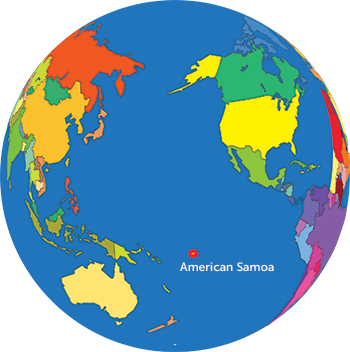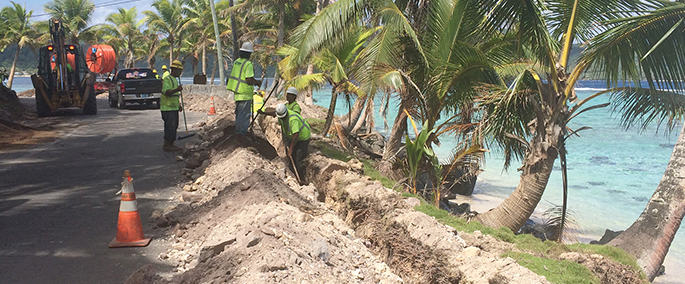December 2015 Vol. 70 No. 12
General
American Samoa Fiber Optic Network

Meticulous Prep, Planning Essential To Success
A combination of thorough planning and field-tested experience is critical to achieving a high level of construction success. This was the case in American Samoa when Michels Communications was given about 18 months to build a robust fiber optic network on the five inhabited islands in the only American territory south of the equator.
 In 2010, the American Samoa Telecommunications Authority (ASTCA) received funding through the America Recovery and Reinvestment Act (ARRA) to replace its deteriorating legacy copper network with a weather-durable fiber optic network. The Broadband Linking the American Samoa Territory (BLAST) project called for a Next Generation Network to deliver high-speed data, video, voice, public network computing and cellular backhaul services to every household, business and critical institution in American Samoa.
In 2010, the American Samoa Telecommunications Authority (ASTCA) received funding through the America Recovery and Reinvestment Act (ARRA) to replace its deteriorating legacy copper network with a weather-durable fiber optic network. The Broadband Linking the American Samoa Territory (BLAST) project called for a Next Generation Network to deliver high-speed data, video, voice, public network computing and cellular backhaul services to every household, business and critical institution in American Samoa.
In a world where instantaneous global connectivity is the norm, telecommunications is considered a critical component of American Samoa’s economic development plan. It is hoped that an improved electronic link between American Samoa and the rest of the world will allow for the development of new opportunities for e-commerce, informational technology-based enterprises, educational and workforce development initiatives, medical research and other broadband-based initiatives, according to the American Samoa Economic Development Implementation Plan.
The project was originally planned as an open cut, concrete-encased PVC underground system. When budgetary concerns threatened to shut down the project before it was started, officials from ASTCA and Mid State Consultants turned to Michels Communications’ Vice President Jerrod Henschel and Manager Ed Rurup to develop a still reliable, but more budget-friendly alternative that would adhere to the allocated funds while still allowing Michels to install more than 450 miles of cable on five islands.
Having previously completed projects in the South Pacific, including projects in Guam and the Marshall Islands, Michels was very interested in collaborating with the owner to make sure this project would be a success and bring much needed improvement to the telecommunications infrastructure in the territory. Henschel and Rurup established unit prices for a wide variety of construction techniques, primarily featuring the use of directional drilling and HDPE duct. The idea was to give the resident engineer and project manager some flexibility in using the most effective construction methods, based upon the site conditions they were facing at any given time. With this plan in place, ASTCA contracted with Michels Communications to build the FTTH (Fiber to the Home) system on the islands of Tutuila, Aunu’u, Ofu, Olosega and Ta’u.
Staging
Fast forward to fall 2013. With the contract signed, Michels began to implement the mobilization plan for the project. Based in Brownsville, WI, Michels’ crews routinely work on projects from coast to coast and in remote and highly populated areas. Nonetheless, preparing to spend a year and a half working on a small group of islands midway between Hawaii and New Zealand in the South Pacific Ocean – 6,500 air miles from Michels’ headquarters – required particularly diligent and detailed planning.
Due to the isolated location, lack of industry-specific suppliers and retailers on the islands, and unreliable mainland delivery
options, the Michels team packed the supplies and equipment needed to be a self-sufficient operation. Initially Michels shipped 18, 40-foot containers and 13 flat racks of equipment and materials by rail and truck from its headquarters in Wisconsin to container ships in Oakland, CA, for their arrival in American Samoa. Supplies ranged from small items such as connectors and tools, to large equipment including directional drill rigs and rock saws. Additional supplies, such as fiber optic cable and duct, were shipped directly from the supplier. ASTCA provided the manholes.
Planning was critical throughout the project. It took from several weeks to several months for supplies and equipment to arrive from the United States (and it was even longer during a dockworkers strike in California that halted the shipment of most supplies to the islands). Orders needed to be placed many months in advance for additional equipment and supplies; communication was constant between the team in American Samoa and Michels support teams in Brownsville.
“We needed to have our plans in place more than three months in advance,” said Project Manager Randy Thompson. “Any less than that and we knew we would not have had the supplies needed to complete our work.”
At the same time equipment and supplies were being packed, about two dozen crewmembers received intense training in safety and advanced first aid as well as a general orientation about working and living in American Samoa. The HSE plan included strategies for safely working in a tropical climate where year-round temperatures ranged from 77 to 90 degrees,
humidity hovered between 70 and 95 percent and rainfall averaged 125 inches per year.
“This project really tested our crews,” Thompson said. “They needed to stay on task and work hard to meet a strict deadline. I’m proud of them for the way they handled themselves and the work.”
Construction
Upon arrival on Tutuila in September 2013, the Michels team started a dual mission of staging a one-acre, fenced yard in the village of Tafuna and navigating American Samoa’s culture, both essential to being able begin construction in the coming new year.
Construction started on 76-square mile Tutuila, American Samoa’s largest island and home to 90 percent of its 55,000 residents. Like the other islands, Tutuila is a combination of basalt and volcanic rock with mixed layers of soil and rock at varying depths on the surface. Michels’ strategy was to bury all mainline cable in HDPE ducts, using directional drilling in all conditions except solid rock, when open trenching was required.
Michels’ plan was to divide the island into nine service areas and to complete construction in one service area before moving onto the next. The service areas were connected to one another with a backbone mainline buried along or under the three main roads that ring about two-thirds of the island. Drilling, trenching and manhole crews coordinated their efforts to completely and efficiently execute each service area plan. Aerial crews completed individual connections from the mainline to residences and business. The largest service area on Tutuila had 1,033 service connections while the smallest has 164. In total, more than 4,250 connections were made.
Because the project required a substantial amount of underground construction, one of the biggest challenges was the lack of a one-call system or essentially any as-built records of existing underground utilities, including sewer and water lines. Instead, crews relied on the memories of utility company employees, village elders and residents to help locate utilities. Once a utility was roughly located, crews used vacuum excavators to dig potholes for visual inspections. All drilling and trenching was done to a minimum depth of 24 inches to avoid as many utilities as possible. Deeper excavations reduced the risk of interfering with other utilities, but generally required work to be done in hard rock which increased cost and took more time. Neither was a desirable option given the rigidity of the project’s timeline and budget, Thompson said.
Directional drilling was a new, but effective method of construction in American Samoa. Michels used two drill rigs at the start of the project, but had two more shipped over to complete the work. Bores ranged from 100 to 900 feet in length and allowed crews to work under American Samoa’s limited roadways. In total, crews placed 205 miles of underground cable and 123 miles of both aerial service wire and aerial cable.
Michels supported its cable installation by placing 48 miles of duct, including 33 miles of horizontal directional drilling and 15 miles of cable using trenching, Rurup said.
Working on outer islands
When the work on Tutuila was 80 percent completed, the crews branched out to the significantly smaller outer islands. The 1/2–square-mile Aunu’u is located about a mile off the eastern shore of Tutuila. Because there is no commercial transport to Auunu’u, all personnel and material were transported to the island via small passenger boats. Because heavy equipment could not be transported to the island, boring was not possible. Instead, trenching was used to bury the 22 service connections.
The remaining three inhabited islands, known as the Manu’a Islands group, are located 70 miles east of Tutuila. Michels chartered a boat to ship supplies and equipment to the islands. The three-square-mile Ofu and two-square-mile Olosega are connected by a one-lane bridge across a strait. Nearby Ta’u covers 17 square miles.
Crews spent about two months working in the Manu’a Islands group, delivering service to 100 customers on Tau and Olosega and 69 on Ofu, boring about 40,000 feet and trenching more than 25,000 feet. Although the work was similar on all of the American Samoa islands, conditions were more challenging on the Manu’a Islands. Because the islands are small, very remote and sparsely populated, few amenities are available. Crew members lived with island residents and relied on the leadership team in Tafuna to ship all necessary items, including not only equipment and job supplies but also essentials like food and water.
Cultural considerations
Assimilating to life in American Samoa was critical to the success of the project, Thompson said. Crews learned about and respected local traditions like not working on Sundays and avoiding all interference with sacred fruit-bearing trees. Whenever possible, the Michels crew members interacted with local residents and frequently worked with two local contractors, Happy Trucking and Paramount Builders.
Establishing strong and trusting bonds with local residents was essential. When the project was completed in July, Michels’ crews donated some of its equipment and supplies to local service organizations and left ASTCA with detailed plans that show where the new facilities are located. American
Samoa also received a state-of-the-art network with potential to support tremendous growth, Henschel said.
“This was a unique opportunity for us to show the kind of work we can do,” he said. “It was a great adventure for our employees and we’re proud to have delivered a quality project that will service the people of American Samoa for many years to come.”
FOR MORE INFORMATION:
Michels Corporation
(920) 924-4300, www.michels.us





Comments